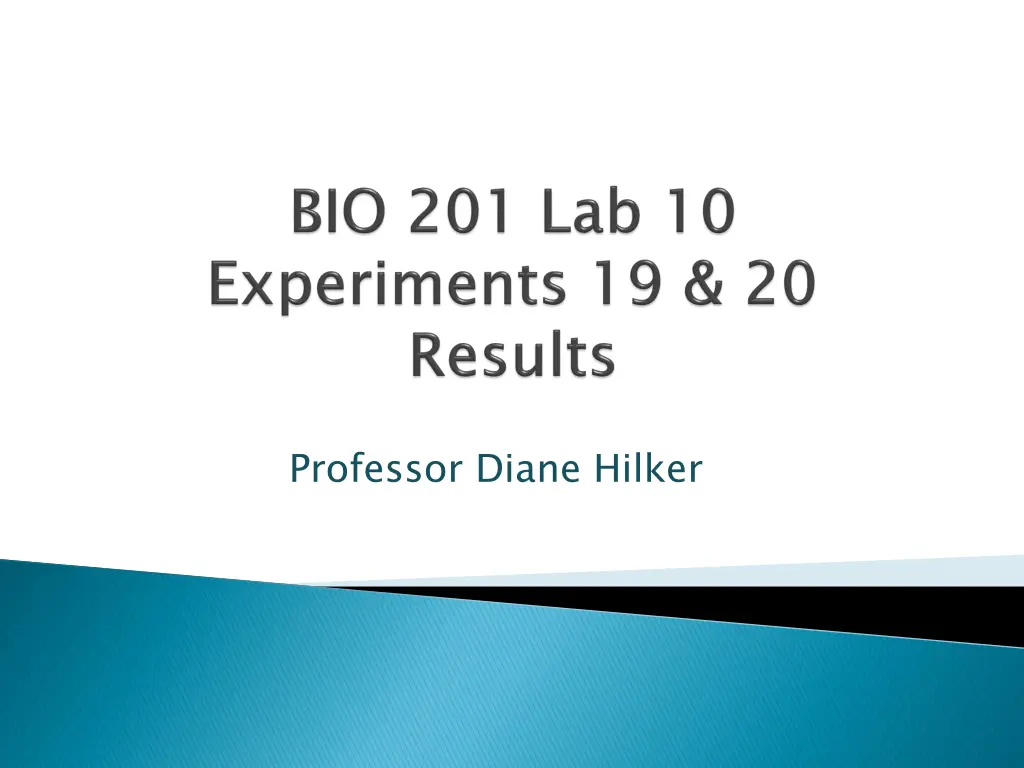
Water Analysis for Fecal Contamination & Microbial Testing Procedures
Dive into the meticulous process of water analysis for fecal contamination led by Professor Diane Hilker. Explore the tests performed, including the Presumptive Test and Confirmed Test, to detect microbes like E. coli and Enterobacter. Discover the significance of these analyses in ensuring water safety and preventing potential health hazards from waterborne diseases.
Download Presentation

Please find below an Image/Link to download the presentation.
The content on the website is provided AS IS for your information and personal use only. It may not be sold, licensed, or shared on other websites without obtaining consent from the author. If you encounter any issues during the download, it is possible that the publisher has removed the file from their server.
You are allowed to download the files provided on this website for personal or commercial use, subject to the condition that they are used lawfully. All files are the property of their respective owners.
The content on the website is provided AS IS for your information and personal use only. It may not be sold, licensed, or shared on other websites without obtaining consent from the author.
E N D
Presentation Transcript
Exp. 19: Water Analysis for Fecal Contamination Exp. 19: Water Analysis for Fecal Contamination I. I. Exp. 20: Quantitative Analysis of H Exp. 20: Quantitative Analysis of H2 2O O II. II.
Purpose: standard H2O analysis test for fecal contamination Waterborne Diseases: Shigella, Giardia, Salmonella Fecal Indicator: Chlorine kills: viruses and some Gram pos. & protozoa Normal Flora Chlorinated H Non-pathogenic Gram pos. saprophytes Purpose: To learn & perform the 3 stage Waterborne Diseases: E. coli, HAV, Polio, Fecal Indicator: E. coli Chlorine kills: Gram negative bacteria, Normal Flora Chlorinated H2 2O: O:
3 Tests Performed 3 Tests Performed I. Presumptive Test PRLB Tube Broth with a Durham Tube I. Presumptive Test PRLB Tube-Phenol Red Lactose 3 Reactions: *1. Red/orange with or without gas *2. Yellow without gas **3. Yellow with gas: lactose fermenter *Potable or drinkable **More testing necessary 3 Reactions:
3 Tests Performed 3 Tests Performed I. Presumptive Test 3 Reactions I. Presumptive Test 3 Reactions
3 Tests Performed 3 Tests Performed I. Presumptive Test Yellow with Gas 1 1. E. coli I. Presumptive Test Yellow with Gas- -3 possible microbes . E. coli : 3 possible microbes : Gram neg. rod 2. 2. Enterobacter Enterobacter sp. sp.: : Gram neg. rod 3. 3. Clostridium sp. Clostridium sp.: : Gram pos. rod
3 Tests Performed 3 Tests Performed II. Confirmed Test Test a tube that is yellow with gas to see which microbe is present EMB Plate: Inhibit Gram pos. Allow certain Gram neg. lactose fermenters to grow Do a T-Streak, 24 hrs. at 37oC II. Confirmed Test EMB Plate: Eosin Methylene Blue
3 Tests Performed 3 Tests Performed II. Confirmed Test 3 Possible Observations on EMB 1. No Growth: Clostridium 2. Growth: Beige colony-Enterobacter 3. Growth: Green Metallic Sheen-E. coli II. Confirmed Test 3 Possible Observations on EMB
3 Tests Performed 3 Tests Performed III. Completed Test Take the green metallic sheen colony and do the following: 1. Repeat PRLB 2. Grow on Nutrient Agar -Do a Gram Stain III. Completed Test Repeat PRLB: yellow with gas Gram Stain: Gram neg. rod Confirms that E. coli is present! Confirms that E. coli is present!
Follow Instructors Directions Follow Instructor s Directions
Exp. 19: Water Analysis for Fecal Contamination Exp. 19: Water Analysis for Fecal Contamination I. I. Exp. 20: Quantitative Analysis of H Exp. 20: Quantitative Analysis of H2 2O O II. II.
Purpose: H2O may still contain bacteria and be safe to drink. To compare the number of bacteria in tap vs. well H2O. Purpose: To test the hypothesis that potable Is chlorinated water sterile? What microbes would be present? Which sample should have more microbes, well or tap water? Follow Instructor s Directions Is chlorinated water sterile? What microbes would be present? Which sample should have more microbes, well or tap water? Follow Instructor s Directions
Exp. 15: Physiology of Bacteria Exp. 15: Physiology of Bacteria I. I.
Purpose: activities of microbes that are frequently used to identify bacterial species. Purpose: To examine specific enzymatic Experiment 21 (Table 9 & Figure 8): Highlight the following Gram Neg. rods Escherichia coli Enterobacter aerogenes Citrobacter freundii Serratia marcescens Proteus vulgaris Pseudomonas sp. Experiment 21 (Table 9 & Figure 8): Highlight the following Gram Neg. rods
Follow Instructors directions Follow Instructor s directions
